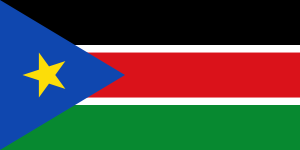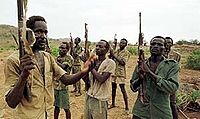- Sudan People's Liberation Army/Movement
-
Not to be confused with the Sudan People's Liberation Movement in North Sudan or the Sudan Liberation Movement/Army in Darfur.
Sudan People's Liberation Movement 

Chairman Salva Kiir Mayardit Founded 1983 Headquarters Juba, South Sudan Newspaper SPLM Today Ideology New Sudan Politics of South Sudan
Political parties
ElectionsThe Sudan People's Liberation Movement (SPLM) is a political party in South Sudan. It was initially founded as a rebel political movement with a military wing known as the Sudan People's Liberation Army (SPLA)estimated at 180,000 soldiers. The SPLM fought in the Second Sudanese Civil War against the Sudanese government from 1983 to 2005. In 1989, it joined the main opposition group in Sudan, the National Democratic Alliance (NDA), which in January 2005 signed a Comprehensive Peace Agreement with the Sudanese government. SPLA/M has since had representatives in the Government of Sudan, and was the main constituent of the Government of the then semi-autonomous Southern Sudan. South Sudan became a sovereign state on 9 July 2011.[1]
It was led by John Garang until his death on 30 July 2005. It is now led by Salva Kiir Mayardit who is also the President of Southern Sudan and Vice President of Sudan. In 2007, Gen. Dominic Dim Deng, a prominent General, was appointed Minister for SPLA Affairs. The first political leader of the Sudan People's Liberation Army. Gen. Dominic Dim Deng, his wife and 21 other senior Officers, including senior SPLM official Dr. Justin Yac Arop, died in a plane incident on 2 May 2008. He was buried together with his wife, after a full state ceremony, at the SPLA General Headquarters in Juba.
According to Mennan, the Dinka tribe—who formed the core leadership of the SPLA, the signatory of the CPA—dominate the Government of Southern Sudan.'[2]
Contents
History
The SPLM was established on 16 May 1983, and published a manifesto setting out its positions. Joseph Oduho was made chairman and Colonel John Garang, a Dinka army officer, was made commander of the Sudan People's Liberation Army (SPLA). Later Oduho was deposed by Garang, who made himself leader of the SPLA/M.[3]
The SPLA/M as a rebel group was formed in 1983, after the Sudan government's abandonment of the Addis Ababa agreement signed between the Gaafar Nimeiry government and the Anyanya leader Joseph Lagu who first introduced the Southern Sudanese to the effective political, economic, social, educational, and religious situations they would face after Sudan's independence. Accordingly he started the SPLA/M, which was a group of rebellious south Sudanese soldiers of the Sudanese Army based in Bor, Pochalla, and Ayod (first called the Bor Mutiny). These joined remnants of the Anyanya rebels of the First Sudanese Civil War based in Ethiopia.
Founders of the SPLA included Captain Salva Kiir Mayardit, Samuel AbuJohn Khabas, Major William Nyuon Bany, Major Kerubino Kuanyin Bol and many other South Sudanese officers of the Sudan armed forces. It fought against the governments of Gaafar Nimeiry, Sadiq al-Mahdi and Omar Hasan Ahmad al-Bashir in what is now called the Second Sudanese Civil War. SPLA/M's declared aim was to establish a democratic Sudan with it as the leading party in control of the southern areas. The war has been largely described in religious and ethnic terms, and also as a struggle for control of the water and oil resources located in southern and western Sudan.
In early 1991, the SPLA-Nasir faction led by Dr Riek Machar and Dr Lam Akol attempted to overthrow chairman Garang. The attempt failed but led to widespread fighting in the south and the formation of other rebel groups, such as Kerubino Kwanyin Bol's SPLA Bahr-al-Ghazal faction. These internal divisions hampered negotiations with the government. SPLA-Nasir renamed itself SPLA-United and then transformed itself, with substantial personnel changes, into the South Sudan Independence Movement/Army. Several smaller factions signed the Khartoum Peace Agreement with the government in April 1997 and formed the United Democratic Salvation Front (UDSF).
In July 1992, a government offensive seized southern Sudan, and captured the SPLA headquarters in Torit.[4]
In 2004, a year before the peace deal, the Coalition to Stop Child Soldiers, estimated that there were between 2,500 and 5,000 children serving in the SPLA.[5]
The Sudanese government accused Uganda and Eritrea of supporting the SPLA/M. The group is alleged to have operated on the Ugandan side of the Sudanese border with Uganda at the southern limit of Sudan.
In 2005, a treaty between the SPLA/M and the Sudanese government led to the formal recognition of Southern Sudanese autonomy. The political wing, the Sudan People's Liberation Movement (Al-Harakat Ash-Shaabia Le Tahreer As-Sudan), is now a political party. It joined the government as part of the 2005 peace agreement, gaining about one-third of government positions. On 11 October 2007, the SPLM withdrew from the government, alleging violations of the peace agreement; this raised concerns about the future of the agreement.[6]
A 2008 US diplomatic cable concerning the reaction to the seizure of MV Faina by pirates, along with its cargo of T-72 tanks, anti-aircraft guns and other heavy armaments, describes as a 'poorly-kept secret' the fact that the weapons' original destination was to be not Kenya but South Sudan. A 2009 cable highlights how the Kenyan government was 'understandably confused' by the US reaction and threats of sanctions against Kenya if the shipment were to proceed, since 'past transfers had been undertaken in consultation with the United States' and 'dove-tailed' with US aims to convert the SPLA from a guerrilla force into a small conventional army capable of defending Juba, and in addition the US is 'continuing military to military security sector reform assistance to the SPLA'.[7][8][9]
Richard Rands writes that:[10]
- The SPLA is increasingly vulnerable when faced with multiple threats and challenges throughout the South. Recently, it has been threatened by militia leaders such as George Athor Deng,[11] David Yauyau [both in Jonglei State] and Gatluak Gai;[12] concurrently, the force is dealing with Lord's Resistance Army threats in Western Equatoria and Western Bahr el Ghazal.[12] If there were to be a threat of proxy forces along the border areas and major issues with white army militias,[12] or if there were dissent in any of the units, its capacity to manage the army effectively could easily be compromised.
Following independence in 2011, the SPLA will form the core of the armed forces of South Sudan.
See also
- Ethiopian People's Liberation Army
References
- ^ Martell, Peter (2011 [last update]). "South Sudan becomes an independent nation". BBC. http://www.bbc.co.uk/news/world-africa-14089843. Retrieved 9 July 2011.
- ^ http://www.williamtsuma.com/sites/default/files/towards-system-legal-pluralism-south-sudan.pdf, African Policy Journal, Spring 2007, Vol. 3
- ^ "A CHRONOLOGICAL HISTORY". European Sudanese Public Affairs council. 19 April 1985. http://www.espac.org/peace_process/search_for_peace3.asp. Retrieved 17 August 2011.
- ^ Karl R. DeRouen and Uk Heo. Civil wars of the world: major conflicts since World War II. 1. ABC-CLIO. p. 748.
- ^ http://www.sudantribune.com/SPLA-to-demobilize-all-child,36125
- ^ "Southern Sudan party pulls out of unity government", Associated Press (International Herald Tribune), 11 October 2007.
- ^ Gettleman, Jeffrey; Gordon, Michael R. (8 December 2010). "Pirates' Catch Exposed Route of Arms in Sudan". New York Times. http://www.nytimes.com/2010/12/09/world/africa/09wikileaks-tank.html?src=mv. Retrieved 31 December 2010.
- ^ Ranneberger (2 October 2008). Whither M/V Faina's tanks?. WikiLeaks. WikiLeaks cable:08NAIROBI2290. Archived from the original on 10 January 2011. http://wikileaks.ch/cable/2008/10/08NAIROBI2290.html. Retrieved 31 December 2010.
- ^ Ranneberger (16 December 2009). Kenya responds to Sudan tank demarche. WikiLeaks. WikiLeaks cable:09NAIROBI2497. Archived from the original on 10 January 2011. http://wikileaks.ch/cable/2009/12/09NAIROBI2497.html. Retrieved 31 December 2010.
- ^ Richard Rands, In Need of Review: SPLA Transformation in 2006–10 and Beyond, HSBA-Small Arms Survey, Working Paper 23, November 2010, p.26-7
- ^ George Athor Deng is a long-time SPLA combatant. After the signing of the CPA Athor became Upper Nile then Jonglei division commander and finally SPLA Deputy Chief of Staff for Political and Moral Orientation. He is quite representative of the post CPA SPLA top officers. Numerous rumors are accusing him to be involved into weapons smuggling, traffic of influence and misappropriation of funds both in Jonglei and Upper Nile. He was also deeply involved in the White Army bloody disarmament in 2006. Marc-Andre Lagrange, Insurgencies in South Sudan: A Mandatory Path to Build a Nation?, 11 December 2010
- ^ a b c http://www.smallarmssurveysudan.org
Further reading
- SPLM/SPLA: The Nasir Declaration Lam Akol, iUniverse, In August 1991, three members of the SPLM/SPLA Political-military High Command made the Nasir Declaration. This led to the split of the Movement. One of the leaders of the move(many say, THE ringleader) gives an account of the events that led to this momentous event in the SPLM/SPLA history, the developments that followed, what went wrong in the process, how the move affected Sudanese politics and the way forward for South Sudan., $26.95, PB ISBN 13: (978-0-595-28459-7) 2003 (Description from 2009 American Library Association annual conference book listing.)
- What Is the What: (2006) The Autobiography of Valentino Achak Deng by Dave Eggers based on the real life story of Valentino Achak Deng, a Sudanese refugee and member of the Lost Boys of Sudan program
External links
- Official website of the Sudan People's Liberation Movement/Army
- Federation of American Scientists page
- State Department archive on Sudan Project before January 2001
- Description of SPLA/M from pro-rebel bias.
- Garang's Death: Implications for Peace in Sudan by the International Crisis Group, 9 August 2005 (PDF)
- Sudan Photographic Exhibition – Documentary photographer's images of Sudan's displaced
Political parties in South Sudan 
Sudan People's Liberation Movement - United Democratic Front - Sudan African National Union - South Sudan Liberal Party Categories:- Sudan People's Liberation Movement
- Guerrilla organizations
- Political parties established in 1983
- Political parties in South Sudan
- Political parties in Sudan
- Rebel groups in Uganda
- Rebel groups in Sudan
- Second Sudanese Civil War
- Secession in Sudan
Wikimedia Foundation. 2010.

